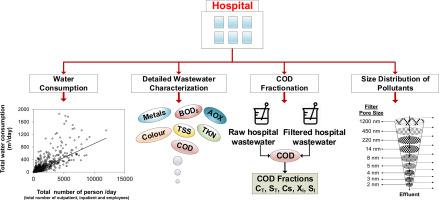Journal of Water Process Engineering ( IF 7 ) Pub Date : 2021-07-19 , DOI: 10.1016/j.jwpe.2021.102205 Selda Murat Hocaoglu 1 , Mehtap D. Celebi 1 , Irfan Basturk 1 , Recep Partal 1

|
This study investigated detailed characterization of hospital wastewater, size distribution of major organic pollutants and COD fractionation. In order to estimate the amount of wastewater, water consumption values and number of patients from 1156 hospitals were assessed statistically, and hourly water consumption data of a middle size hospital were recorded. Significant differences were observed in the total water consumption of the hospitals even among the ones having similar bed capacities. The average daily water consumption per hospital was about 140 m3, while the 1st and 3rd quartile were 25 m3 and 150 m3 respectively. Pollutant size distribution (PSD) analysis provided specific fingerprints for COD, BOD, colour and AOX parameters of hospital wastewater. Size distribution analyses resulted that about 20% of the AOX was in size range smaller than 1 kDa which might be attributed to adsorbable iodinated compounds (AOI) generated in iodinated X-ray process. According to the PSD results, it can be estimated that up to 85-90% of the total COD and 75-80% of the total AOX can be removed by direct filtration process using an ultrafiltration-sized membrane. COD fractionation experiments revealed that hospital wastewater has more soluble inert COD content than domestic wastewater with a similar COD concentration. Therefore, slightly higher COD concentrations can be expected at the biological treatment effluent of hospital wastewater compared to domestic wastewaters with similar COD concentrations. The difference may be attributed to the use of various chemicals and cleaning agents of inert properties.
中文翻译:

基于处理的医院废水表征和污染物分馏
本研究调查了医院废水的详细特征、主要有机污染物的粒径分布和 COD 分馏。为了估算废水量,对来自1156家医院的用水量和患者人数进行了统计评估,并记录了一家中等规模医院的每小时用水量数据。即使在床位相似的医院之间,医院的总用水量也存在显着差异。每家医院平均每日用水量约为140 m 3,而第1和第3四分位数分别为25 m 3和150 m 3 。分别。污染物粒径分布 (PSD) 分析为医院废水的 COD、BOD、颜色和 AOX 参数提供了特定的指纹。尺寸分布分析结果表明,约 20% 的 AOX 的尺寸范围小于 1 kDa,这可能归因于碘化 X 射线过程中产生的可吸附碘化化合物 (AOI)。根据 PSD 结果,可以估计使用超滤尺寸的膜通过直接过滤过程可以去除高达 85-90% 的总 COD 和 75-80% 的总 AOX。COD 分馏实验表明,医院废水的可溶性惰性 COD 含量高于具有相似 COD 浓度的生活废水。所以,与具有相似 COD 浓度的生活废水相比,预计医院废水生物处理出水的 COD 浓度略高。这种差异可能是由于使用了各种具有惰性的化学品和清洁剂。



























 京公网安备 11010802027423号
京公网安备 11010802027423号